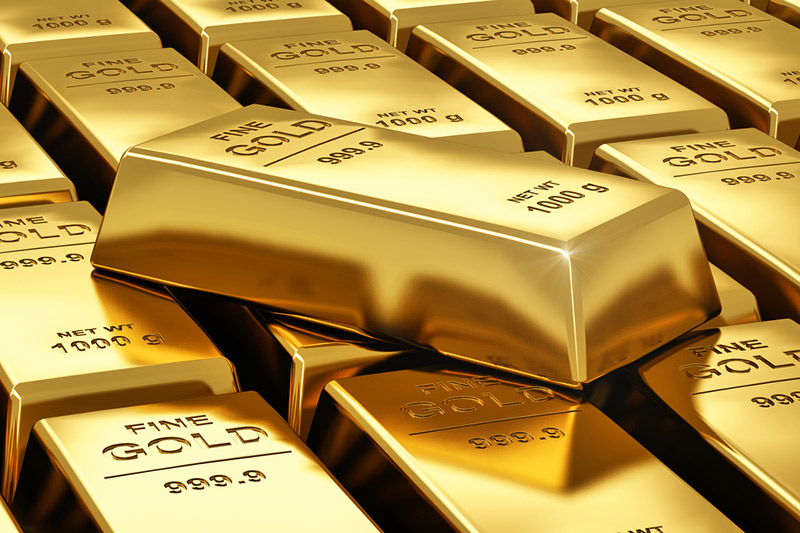Investing.com - Gold futures came under heavy selling pressure during European morning trade on Monday, hovering close to a two-week low as growing fears that the euro zone’s debt crisis could flare up again prompted investors to shun riskier assets and move in to the relative safety of the U.S. dollar.
On the Comex division of the New York Mercantile Exchange, gold futures for June delivery traded at USD1,633.25 a troy ounce during early European trade, dropping 0.55%.
It earlier fell by as much as 0.61% to trade at USD1,632.55 a troy ounce, the lowest since April 19, when prices dropped to a two-week low.
Gold futures were likely to find short-term support at USD1,621.25 a troy ounce, the low from April 5 and resistance at USD1,658.95, the high from April 16.
The euro came under pressure amid uncertainty over the result of France’s presidential election, after President Sarkozy preformed poorly against Socialist candidate Francois Hollande in the first round of the vote.
Hollande has said he wants to renegotiate the euro zone fiscal pact in order to stimulate growth in the euro zone, rather than enforcing strict austerity measures.
Markets were also rattled after Dutch lawmakers over the weekend failed to resolve differences over budget cuts needed to bring the country’s deficit back within the European Union limit of 3% of gross domestic product.
The government is expected to resign within the coming days and call elections later this year, making it the latest European government forced out of office by the continent’s financial crisis.
Also weighing on risk sentiment, Spanish 10-year yields rose above the key 6.0%-level in early trade Monday, hitting 6.05%.
There have been renewed concerns of further debt contagion in the euro zone in recent weeks amid fears Spain will be the next in the euro zone to require a bailout.
Although gold’s appeal as a safe haven is boosted during times of economic uncertainty, the euro zone’s debt crisis has done little to bolster appetite for the precious metal in recent months.
A weakening euro and stronger dollar have weighed on gold instead. The dollar index, which tracks the performance of the greenback versus a basket of six other major currencies, was up 0.37% to trade at 79.58.
Gold's recent tight correlation with the euro leaves the precious metal vulnerable to a sharper pull back should the euro zone’s debt crisis worsen as prices have been tracking movements in the euro in recent weeks.
Gold prices have been stuck in a narrow trading pattern in recent days, as investors search for the next catalyst to take prices higher.
Investors will closely watch a policy meeting at the Federal Reserve next week, seeking cues on the central bank's attitude towards monetary easing. Expectations of monetary stimulus tend to benefit gold, as the metal is seen as a safe store of value and inflation hedge.
Elsewhere on the Comex, silver for July delivery fell 0.95% to trade at USD31.42 a troy ounce, while copper for July delivery tumbled 1.65% to trade at USD3.646 a pound.
On the Comex division of the New York Mercantile Exchange, gold futures for June delivery traded at USD1,633.25 a troy ounce during early European trade, dropping 0.55%.
It earlier fell by as much as 0.61% to trade at USD1,632.55 a troy ounce, the lowest since April 19, when prices dropped to a two-week low.
Gold futures were likely to find short-term support at USD1,621.25 a troy ounce, the low from April 5 and resistance at USD1,658.95, the high from April 16.
The euro came under pressure amid uncertainty over the result of France’s presidential election, after President Sarkozy preformed poorly against Socialist candidate Francois Hollande in the first round of the vote.
Hollande has said he wants to renegotiate the euro zone fiscal pact in order to stimulate growth in the euro zone, rather than enforcing strict austerity measures.
Markets were also rattled after Dutch lawmakers over the weekend failed to resolve differences over budget cuts needed to bring the country’s deficit back within the European Union limit of 3% of gross domestic product.
The government is expected to resign within the coming days and call elections later this year, making it the latest European government forced out of office by the continent’s financial crisis.
Also weighing on risk sentiment, Spanish 10-year yields rose above the key 6.0%-level in early trade Monday, hitting 6.05%.
There have been renewed concerns of further debt contagion in the euro zone in recent weeks amid fears Spain will be the next in the euro zone to require a bailout.
Although gold’s appeal as a safe haven is boosted during times of economic uncertainty, the euro zone’s debt crisis has done little to bolster appetite for the precious metal in recent months.
A weakening euro and stronger dollar have weighed on gold instead. The dollar index, which tracks the performance of the greenback versus a basket of six other major currencies, was up 0.37% to trade at 79.58.
Gold's recent tight correlation with the euro leaves the precious metal vulnerable to a sharper pull back should the euro zone’s debt crisis worsen as prices have been tracking movements in the euro in recent weeks.
Gold prices have been stuck in a narrow trading pattern in recent days, as investors search for the next catalyst to take prices higher.
Investors will closely watch a policy meeting at the Federal Reserve next week, seeking cues on the central bank's attitude towards monetary easing. Expectations of monetary stimulus tend to benefit gold, as the metal is seen as a safe store of value and inflation hedge.
Elsewhere on the Comex, silver for July delivery fell 0.95% to trade at USD31.42 a troy ounce, while copper for July delivery tumbled 1.65% to trade at USD3.646 a pound.
